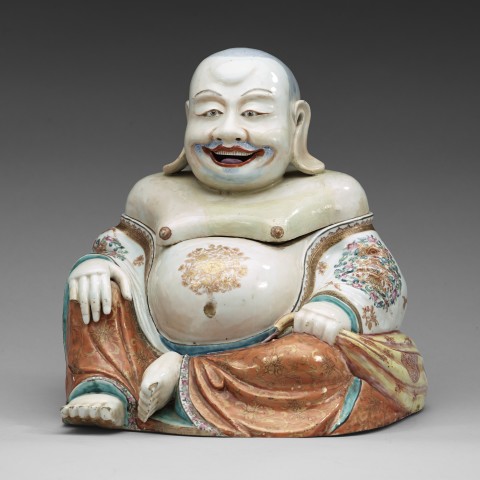Moulded in the shape of a seated Budai, Heshang figure, divided in two parts, tureen and lid, at chest height. The figure is smiling with his mouth open. He has iron red lips and tongue, white teeth, a broad, flat nose, large ears, and eyes, his eyebrows, moustache and beard are painted. His head, shoulders, stomach, hands and bare feet are faintly highlighted in shades of sepia, suggesting flesh colour. His left hand is holding the top of a large cloth sack enamelled in yellow and pink, which stands out against the loose iron red garments decorated with gold floral motifs that falls from his shoulders. Draped above this he is wearing a white cloak decorated with flowers.
Provenance
From the Collection of Berta Berg, wife of Alfred Berg (1871-1920). Thence by descent.
Literature
The Royal Collection has a pair of tureens of very similar form, but with different coloured robes and without the decoration to the stomach, and they are slightly smaller than ours (collection number RCIN 14). They were almost certainly aquired by George IV. They are described in the inventory of the Royal Pavillion, Brighton, as: 'A pair of large Josses (heads take off) with draperies, fourteen inches.' They were sent to Buckingham Palace in March 1847, and are noted thwre in the East Wing in 1917.
Compare with a slightly smaller but almost identical tureen in Hallwylska Museet, Stockholm, Sweden, ref XLVIII:XI:C.h.b.27, acquired by the museum in 1910, illustrated in Rose Kerr; Chinese porcelain in the Hallwyll museum, and a smaller armorial tureen illustrated in Maria Antonia Pinto de Matos, 'The RA Collection of Chinese Ceramics', page 277 lot 529.
Ullman, Magnus; Så levde de. Del II. Page 46-77
Alfred Berg founded the well-known asset management company known as Alfred Berg. He also owned Bukowskis from 1905, and in 1906 he acquired the property at Arsenalsgatan 2, the very premises towards Berzeli Park where Bukowskis are still situated today. He moved in to the floors above the Auction house. He later came to own a large villa in Djursholm as well as the Wijk castle near Uppsala. He was a passionate and famous art collector of the time and filled his houses with antiquities and art. In 1917 he married Berta Nyström and commissioned Anders Zorn to paint her portrait. The couple hosted many extravagant dinners and parties together and shared each other's interests. But unfortunately in 1920 Alfred Berg died from the Spanish flu. Berta Berg inherited the estate after her husband's passing. Berta Berg died in 1927, only 47 years old. She had a child from a previous marriage.
Budai is usually identified with or seen as an incarnation of Maitreya, the future Buddha, so much so that the Budai image is one of the main forms in which Maitreya is depicted in China. He is almost always shown smiling or laughing, hence his nickname in Chinese, the Laughing Buddha. He carries his few possessions in a cloth sack, being poor but content.
According to Chinese history, Budai was an eccentric Chan monk who lived in China in the 1000th Century.
Budai in folklore is admired for his happiness, plenitude, and wisdom of contentment. One belief popular in folklore maintains that rubbing his belly brings wealth, good luck, and prosperity.

